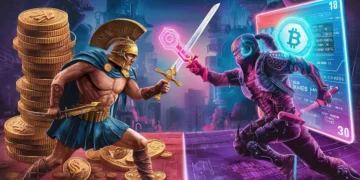The Ethereum Virtual Machine (EVM) is significant in Web3 gaming, changing how games operate, how players interact, and even how virtual assets are owned and traded. If you’re curious about EVM gaming—whether you’re a casual gamer or tech enthusiast—this guide will help you understand what EVM gaming is, how it works, and why it’s essential.
Understanding Ethereum Virtual Machine (EVM)
To understand EVM gaming, you first need to know a bit about the Ethereum Virtual Machine itself. Think of the EVM as the engine that runs applications on the Ethereum blockchain. It interprets smart contracts—self-executing contracts written in code—that control transactions, asset ownership, and interactions within digital environments.
The EVM ensures these contracts execute transparently and reliably across all blockchain nodes, keeping everything fair and consistent.

How Does EVM Gaming Work?
Imagine playing your favourite video game, but instead of everything being managed by a single company, the game rules and ownership of items are transparently controlled by code running on a blockchain. That’s essentially what EVM gaming offers. Here’s how it works in a relatable way:
1. Smart Contract Execution
Every action you take, like winning a battle or completing a quest, triggers a smart contract—a set of pre-defined rules written in code. This means the results of your actions are automatically and transparently updated on the blockchain, potentially making gameplay fairer.
2. In-Game Asset Ownership (NFTs)
Think about all the cool items you’ve ever earned in a video game—maybe a rare sword, a limited-edition skin, or a powerful character. In most traditional games, those items technically don’t belong to you. But with EVM gaming, that changes.
Thanks to NFTs, those digital items are tied to your wallet—not the game developer’s server. You can sell, trade, or hang onto them like prized collectibles. It’s like finally getting the keys to the stuff you’ve worked hard to earn.
3. Decentralized Game Logic
In regular games, all the rules and mechanics are set—and often changed—by the company behind the game. If they decide to nerf your favourite weapon or shut down the server, there’s not much you can do. EVM gaming flips that around.
Here, the rules are coded into smart contracts on the blockchain and shared across the network. In theory, that means no single company can secretly change how things work. It puts more control in players’ hands and helps keep things fair.
4. Player-Owned Economy
Imagine a game where your time and effort can pay off. With EVM gaming, you’re not just playing—you’re participating in an economy. Since your in-game items and currencies are NFTs or tokens, you can sell them to other players or use them across different games.
It turns your gaming experience into something more valuable, giving you a chance to earn while you play. That kind of freedom can make the game world feel a lot more real and rewarding.
Challenges and Solutions in EVM Gaming
But like any emerging technology, EVM gaming also comes with hurdles. Here are the major ones developers and players are working to overcome:
Computational Constraints and High Fees
The EVM has limitations in computational speed and efficiency. Complex real-time calculations can become costly due to the blockchain’s transaction fees—known as gas fees. These costs can be prohibitive, especially on Ethereum’s main network.
Solutions Include:
-
Layer 2 Scaling: Technologies like zkEVM and rollups move intensive computational tasks off-chain, drastically reducing costs and enhancing game complexity without sacrificing blockchain security.
-
EVM-Compatible Chains: Networks like Polygon and Avalanche offer lower fees and faster transactions, making them ideal for gaming applications.
-
Hybrid Models: Some games combine blockchain for asset tracking with off-chain computing for gameplay mechanics, balancing performance and security.
-
Tooling like Foundry and Chainlink VRF (for randomness) is increasingly being used by developers to streamline smart contract deployment, testing, and integration of real-world data into games.

Examples of Popular EVM Gaming Platforms
Several platforms have successfully leveraged EVM to deliver unique gaming experiences:
-
Immutable zkEVM: Immutable offers gaming-focused scalability with reduced transaction fees. Notable games like Gods Unchained, Illuvium, and Ember Sword use Immutable’s solutions to deliver smooth gameplay experiences with secure asset ownership.
-
Polygon: Known for affordability and speed, Polygon supports games like The Sandbox and Sunflower Land. Its ecosystem facilitates game developers looking to scale and integrate easily with Ethereum-based assets.
-
Avalanche: Avalanche’s custom blockchain solution supports games like Crabada and DeFi Kingdoms, offering customized, high-performance gaming environments with low transaction costs.
Interoperability and Cross-Game Experiences
One of the unique strengths of EVM gaming is interoperability—assets created in one game can be used in another. This cross-game compatibility enriches the player’s experience, allowing assets like NFTs to carry value across different gaming environments.
However, true cross-game compatibility is still in early stages. Many challenges remain in standardizing asset formats, adapting game mechanics, and ensuring NFTs are functionally meaningful across different game worlds.
The Future of EVM Gaming
Looking ahead, the potential for EVM gaming is growing quickly. Developers are constantly finding new ways to make these games more scalable and user-friendly, meaning they’re getting easier for everyday players to enjoy. As blockchain technology becomes more efficient, the barrier to entry gets lower—and more people can dive in.
Still, regulatory clarity remains a hurdle. Questions about whether NFTs could be considered securities, how play-to-earn models are taxed, and the legal recognition of digital ownership are issues currently under active debate.
So, what does this mean for you? Whether you love gaming, work in tech, or are looking for new ways to engage with digital assets, EVM gaming has something valuable to offer. It’s changing how we think about ownership, interaction, and value in digital spaces.
The Ethereum Virtual Machine (EVM) is significant in Web3 gaming, changing how games operate, how players interact, and even how virtual assets are owned and traded. If you’re curious about EVM gaming—whether you’re a casual gamer or tech enthusiast—this guide will help you understand what EVM gaming is, how it works, and why it’s essential.
Understanding Ethereum Virtual Machine (EVM)
To understand EVM gaming, you first need to know a bit about the Ethereum Virtual Machine itself. Think of the EVM as the engine that runs applications on the Ethereum blockchain. It interprets smart contracts—self-executing contracts written in code—that control transactions, asset ownership, and interactions within digital environments.
The EVM ensures these contracts execute transparently and reliably across all blockchain nodes, keeping everything fair and consistent.

How Does EVM Gaming Work?
Imagine playing your favourite video game, but instead of everything being managed by a single company, the game rules and ownership of items are transparently controlled by code running on a blockchain. That’s essentially what EVM gaming offers. Here’s how it works in a relatable way:
1. Smart Contract Execution
Every action you take, like winning a battle or completing a quest, triggers a smart contract—a set of pre-defined rules written in code. This means the results of your actions are automatically and transparently updated on the blockchain, potentially making gameplay fairer.
2. In-Game Asset Ownership (NFTs)
Think about all the cool items you’ve ever earned in a video game—maybe a rare sword, a limited-edition skin, or a powerful character. In most traditional games, those items technically don’t belong to you. But with EVM gaming, that changes.
Thanks to NFTs, those digital items are tied to your wallet—not the game developer’s server. You can sell, trade, or hang onto them like prized collectibles. It’s like finally getting the keys to the stuff you’ve worked hard to earn.
3. Decentralized Game Logic
In regular games, all the rules and mechanics are set—and often changed—by the company behind the game. If they decide to nerf your favourite weapon or shut down the server, there’s not much you can do. EVM gaming flips that around.
Here, the rules are coded into smart contracts on the blockchain and shared across the network. In theory, that means no single company can secretly change how things work. It puts more control in players’ hands and helps keep things fair.
4. Player-Owned Economy
Imagine a game where your time and effort can pay off. With EVM gaming, you’re not just playing—you’re participating in an economy. Since your in-game items and currencies are NFTs or tokens, you can sell them to other players or use them across different games.
It turns your gaming experience into something more valuable, giving you a chance to earn while you play. That kind of freedom can make the game world feel a lot more real and rewarding.
Challenges and Solutions in EVM Gaming
But like any emerging technology, EVM gaming also comes with hurdles. Here are the major ones developers and players are working to overcome:
Computational Constraints and High Fees
The EVM has limitations in computational speed and efficiency. Complex real-time calculations can become costly due to the blockchain’s transaction fees—known as gas fees. These costs can be prohibitive, especially on Ethereum’s main network.
Solutions Include:
-
Layer 2 Scaling: Technologies like zkEVM and rollups move intensive computational tasks off-chain, drastically reducing costs and enhancing game complexity without sacrificing blockchain security.
-
EVM-Compatible Chains: Networks like Polygon and Avalanche offer lower fees and faster transactions, making them ideal for gaming applications.
-
Hybrid Models: Some games combine blockchain for asset tracking with off-chain computing for gameplay mechanics, balancing performance and security.
-
Tooling like Foundry and Chainlink VRF (for randomness) is increasingly being used by developers to streamline smart contract deployment, testing, and integration of real-world data into games.

Examples of Popular EVM Gaming Platforms
Several platforms have successfully leveraged EVM to deliver unique gaming experiences:
-
Immutable zkEVM: Immutable offers gaming-focused scalability with reduced transaction fees. Notable games like Gods Unchained, Illuvium, and Ember Sword use Immutable’s solutions to deliver smooth gameplay experiences with secure asset ownership.
-
Polygon: Known for affordability and speed, Polygon supports games like The Sandbox and Sunflower Land. Its ecosystem facilitates game developers looking to scale and integrate easily with Ethereum-based assets.
-
Avalanche: Avalanche’s custom blockchain solution supports games like Crabada and DeFi Kingdoms, offering customized, high-performance gaming environments with low transaction costs.
Interoperability and Cross-Game Experiences
One of the unique strengths of EVM gaming is interoperability—assets created in one game can be used in another. This cross-game compatibility enriches the player’s experience, allowing assets like NFTs to carry value across different gaming environments.
However, true cross-game compatibility is still in early stages. Many challenges remain in standardizing asset formats, adapting game mechanics, and ensuring NFTs are functionally meaningful across different game worlds.
The Future of EVM Gaming
Looking ahead, the potential for EVM gaming is growing quickly. Developers are constantly finding new ways to make these games more scalable and user-friendly, meaning they’re getting easier for everyday players to enjoy. As blockchain technology becomes more efficient, the barrier to entry gets lower—and more people can dive in.
Still, regulatory clarity remains a hurdle. Questions about whether NFTs could be considered securities, how play-to-earn models are taxed, and the legal recognition of digital ownership are issues currently under active debate.
So, what does this mean for you? Whether you love gaming, work in tech, or are looking for new ways to engage with digital assets, EVM gaming has something valuable to offer. It’s changing how we think about ownership, interaction, and value in digital spaces.





















































































buy clomiphene no prescription where can i buy cheap clomid pill generic clomid tablets where can i buy cheap clomid can i get clomid for sale buy generic clomid pill how to get cheap clomiphene price
This is the kind of criticism I rightly appreciate.
The reconditeness in this ruined is exceptional.
order azithromycin 250mg for sale – order tetracycline sale flagyl order
order generic rybelsus 14 mg – order semaglutide 14 mg generic periactin 4 mg pill
order domperidone 10mg – oral cyclobenzaprine buy generic cyclobenzaprine for sale
zithromax 250mg usa – purchase zithromax online cheap bystolic 20mg canada
augmentin 375mg sale – https://atbioinfo.com/ order ampicillin online
order esomeprazole – https://anexamate.com/ nexium 40mg pills
cost coumadin – https://coumamide.com/ order generic hyzaar
cost mobic – tenderness buy meloxicam 15mg online
otc ed pills – fast ed to take site natural ed pills
buy generic amoxicillin for sale – comba moxi order generic amoxil
order diflucan online – https://gpdifluca.com/# buy diflucan 100mg pill
lexapro over the counter – https://escitapro.com/# buy escitalopram 20mg generic
order cenforce 100mg online cheap – cenforce rs cenforce online buy
cialis black 800 mg pill house – on this site cialis how long
when will cialis be over the counter – strong tadafl cialis side effect
buy zantac 300mg generic – https://aranitidine.com/# zantac buy online
buy viagra express delivery – strong vpls viagra men cheap
I’ll certainly return to review more. https://buyfastonl.com/isotretinoin.html
More posts like this would add up to the online time more useful. https://ursxdol.com/get-metformin-pills/
This is a question which is virtually to my fundamentals… Numberless thanks! Quite where can I find the phone details an eye to questions? https://prohnrg.com/product/metoprolol-25-mg-tablets/
This is a theme which is in to my callousness… Myriad thanks! Exactly where can I notice the contact details for questions? viagra professional ou cialis en ligne
With thanks. Loads of erudition! https://ondactone.com/simvastatin/
More posts like this would bring about the blogosphere more useful.
https://proisotrepl.com/product/colchicine/
Thanks an eye to sharing. It’s top quality. http://www.fujiapuerbbs.com/home.php?mod=space&uid=3618570
buy generic dapagliflozin – buy dapagliflozin 10 mg for sale dapagliflozin 10 mg drug
cost xenical – https://asacostat.com/# xenical canada
Thanks an eye to sharing. It’s acme quality. http://iawbs.com/home.php?mod=space&uid=916819